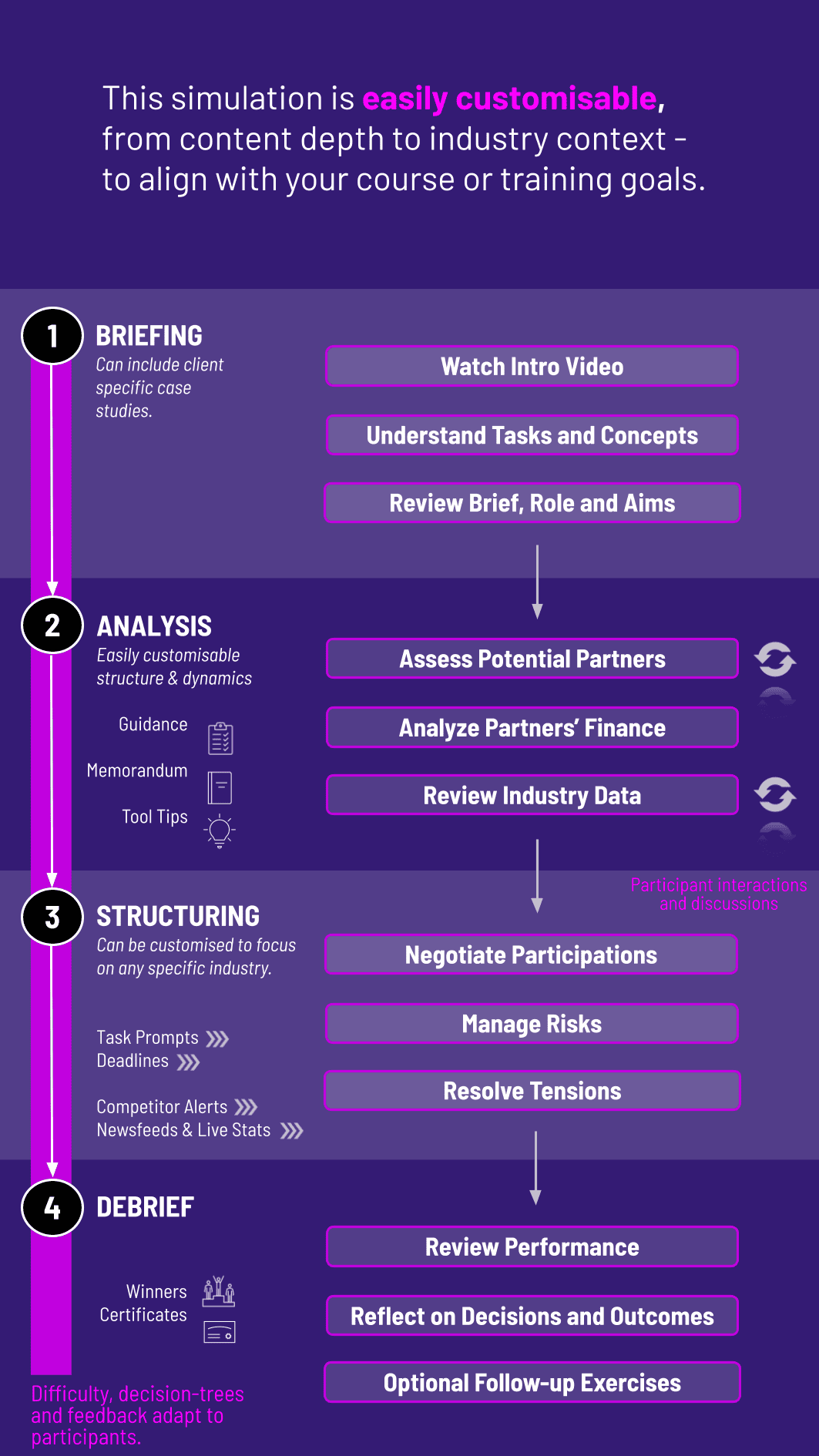
In this hands-on Strategic Alliances Simulation, participants act as corporate leaders forging partnerships - evaluating strategic fit, negotiating terms, and managing collaboration challenges to achieve growth, innovation, and long-term value creation.
Strategic rationale for alliances
Partner selection and due diligence
Governance and decision-making frameworks
Risk-sharing and value creation
Negotiating alliance terms and contracts
Cultural alignment and trust-building
Measuring alliance performance
Conflict resolution and re-negotiation
Managing multi-party alliances and ecosystems
Exit strategies and lessons learned


Assess strategic objectives and identify potential partners
Negotiate alliance structures, governance, and value-sharing terms
Respond to conflicts, cultural differences, and shifting priorities
Communicate alliance progress to boards and stakeholders
Make adjustments when alliances face operational or strategic challenges
Reflect on lessons to improve future alliance management
By the end of the simulation, participants will be able to:
Understand the strategic drivers of alliances
Evaluate partner fit and long-term potential
Negotiate sustainable and balanced alliance agreements
Manage trust, culture, and communication in partnerships
Monitor and measure alliance performance effectively
Resolve conflicts and adapt to shifting circumstances
Recognize risks of dependency or misalignment
Communicate alliance strategies to stakeholders
Balance collaboration with competitive pressures
Design exit and contingency strategies to protect value
The simulation’s flexible structure ensures that these objectives can be calibrated to match the depth, duration, and focus areas of each program, whether in higher education or corporate learning.
The simulation can be run individually or in teams across academic and corporate settings. Each cycle mirrors the lifecycle of an alliance.
1. Receive a Scenario or Brief: Participants are given a business challenge requiring an alliance to achieve growth or innovation.
2. Analyse the Situation: They review partner options, industry data, and strategic objectives.
3. Negotiate Terms: Participants negotiate alliance structures, governance, and financial arrangements.
4. Collaborate Across Roles: Teams role-play as different companies or stakeholders, debating and aligning objectives.
5. Manage the Alliance: They respond to challenges like cultural misalignment, performance disputes, or shifting strategies.
6. Review and Reflect: Feedback highlights alliance performance, stakeholder reactions, and long-term sustainability. Participants refine strategies across multiple rounds.
Do participants need prior strategy experience? No. The simulation introduces alliance concepts in an accessible way.
What industries are included? Scenarios span tech, finance, healthcare, and consumer sectors.
Is it suitable for executives? Yes. It works well for both students and senior professionals.
Can scenarios be customized? Yes. They can reflect industry-specific alliances or cross-border collaborations.
Does it include post-deal management? Yes. Integration and governance challenges are core to the gameplay.
Is it team-based? It can run individually, but works best in teams for negotiation.
Can it be delivered online? Yes. It supports hybrid, online, and in-person delivery.
How long does it run? It can be delivered as a 3-hour module or multi-day workshop.
Is conflict resolution included? Yes. Participants practice managing disputes and re-negotiations.
How is success measured? By alliance stability, strategic outcomes, and communication effectiveness.
Effectiveness in partner evaluation and selection
Quality of negotiation and alliance structures
Communication clarity with stakeholders
Responsiveness to conflicts and evolving challenges
Collaboration and peer/self-assessment in team-based scenarios
You can also include memo writing and debrief presentations as part of the assessment structure. Additionally, you can also add a built-in peer and self-assessment tool to see how participants rate themselves. This flexibility allows the simulation to be easily integrated by professors as graded courses at universities and by HR at assessment centres at companies.
Join this 20-minute webinar, followed by a Q&A session, to immerse yourself in the simulation.
or
Book a 15-minute Zoom demo with one of our experts to explore how the simulation can benefit you.